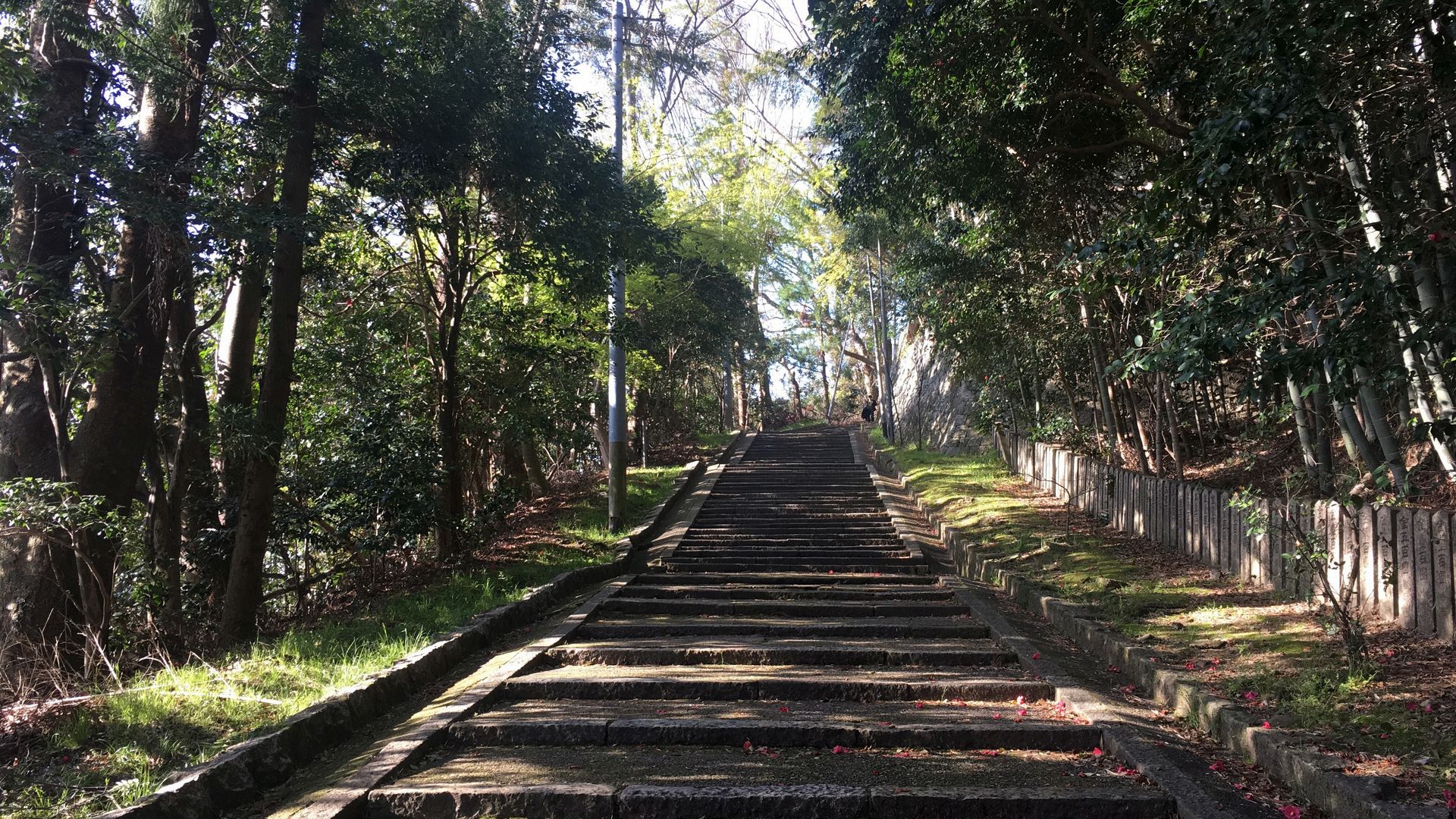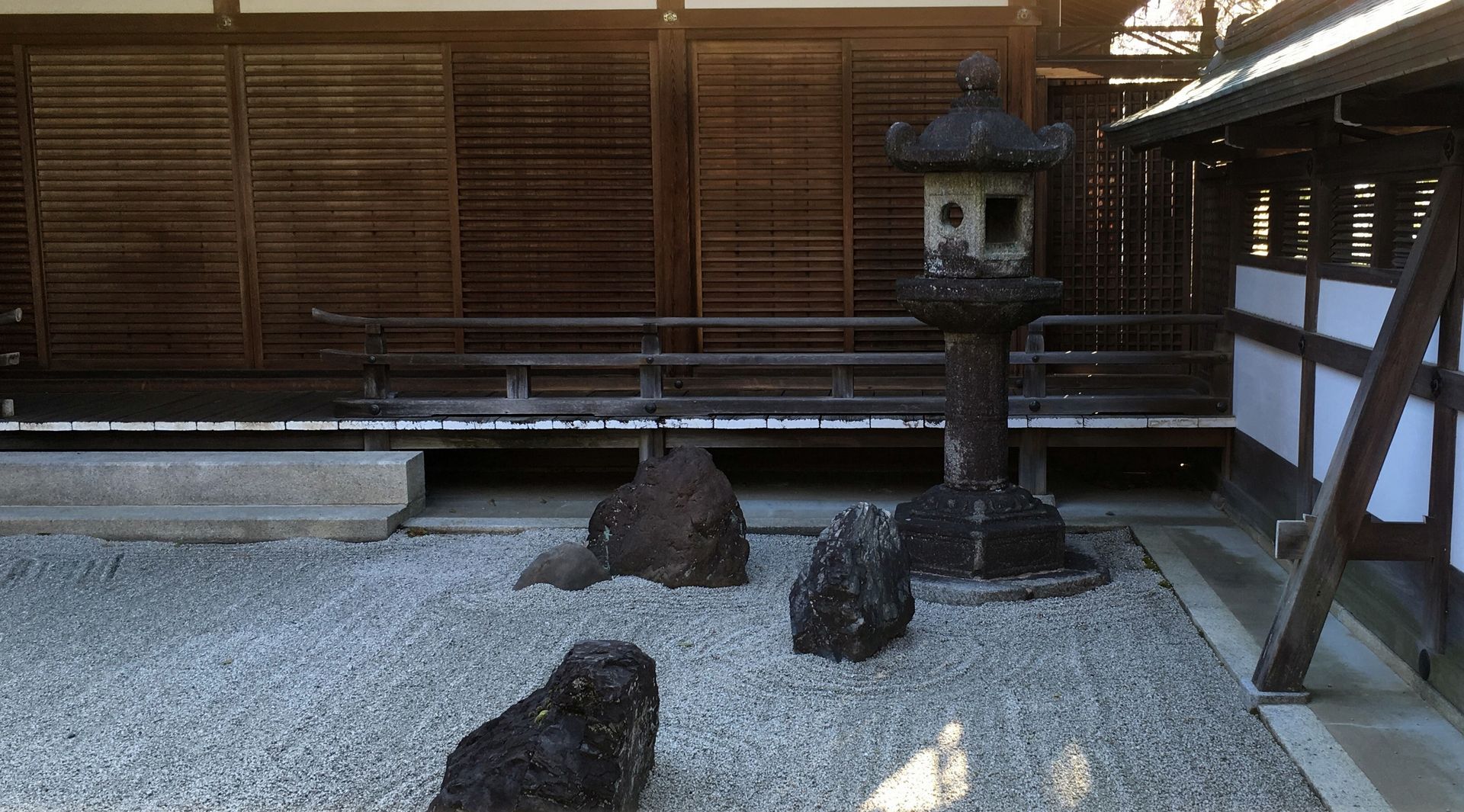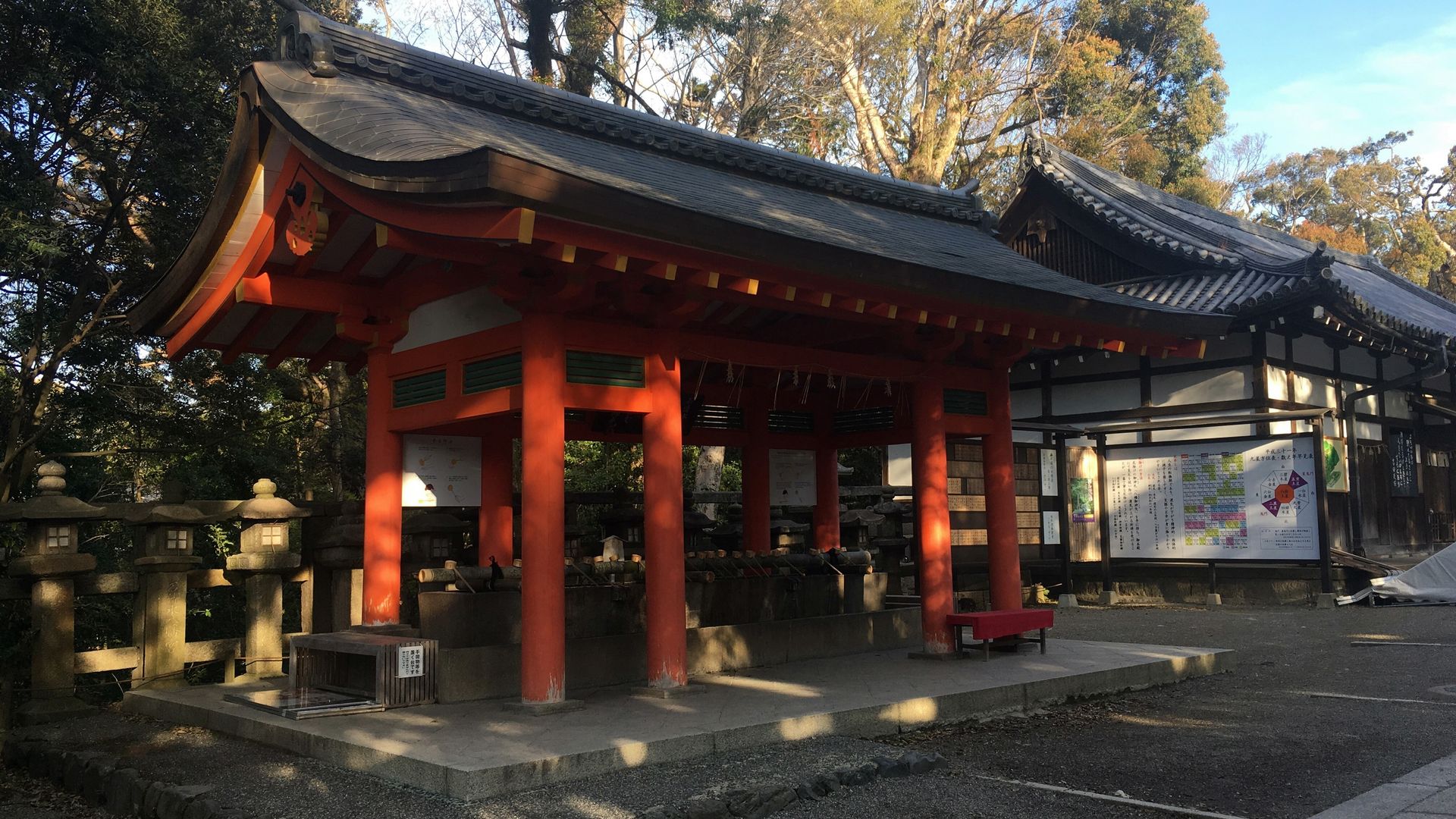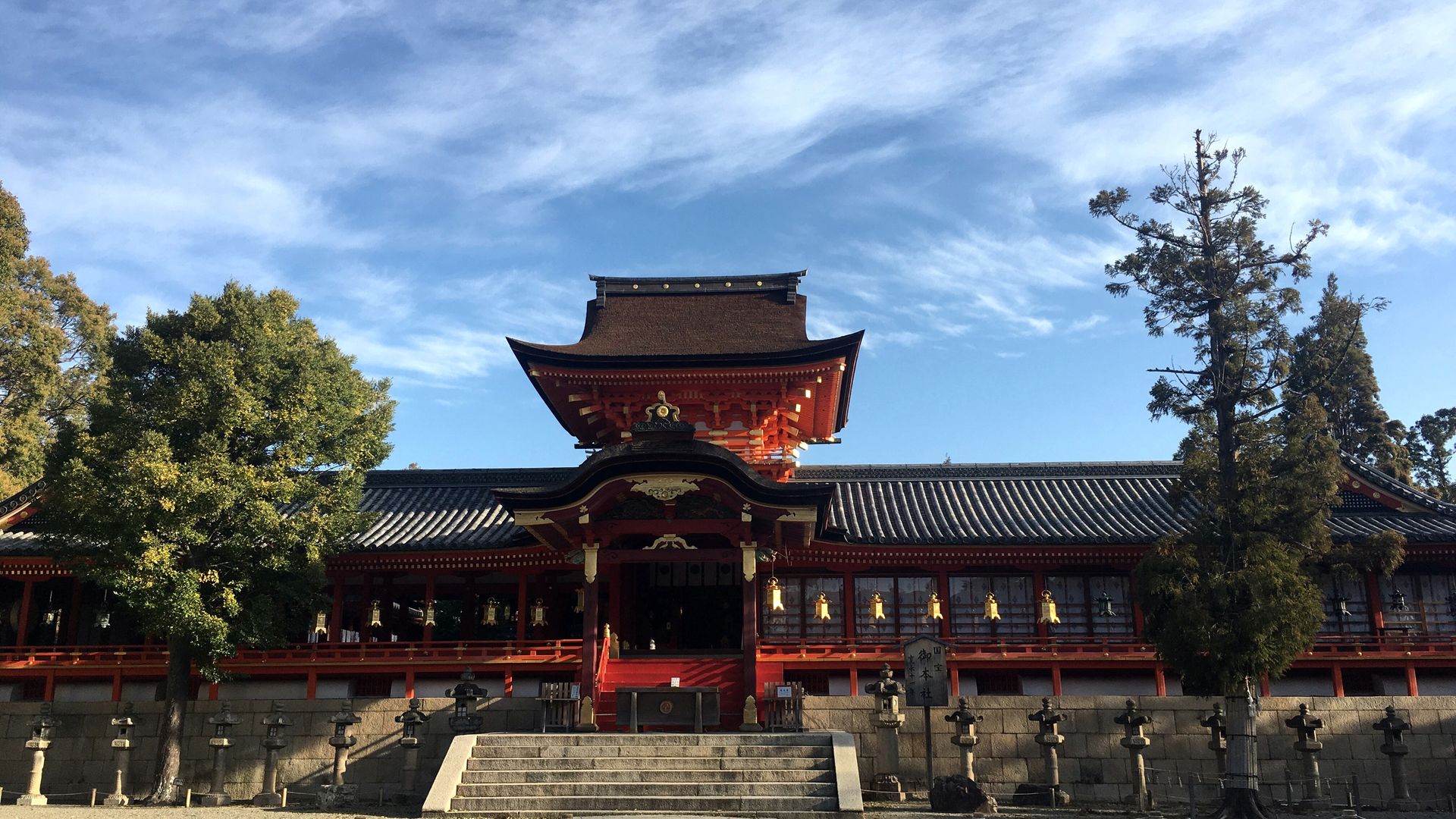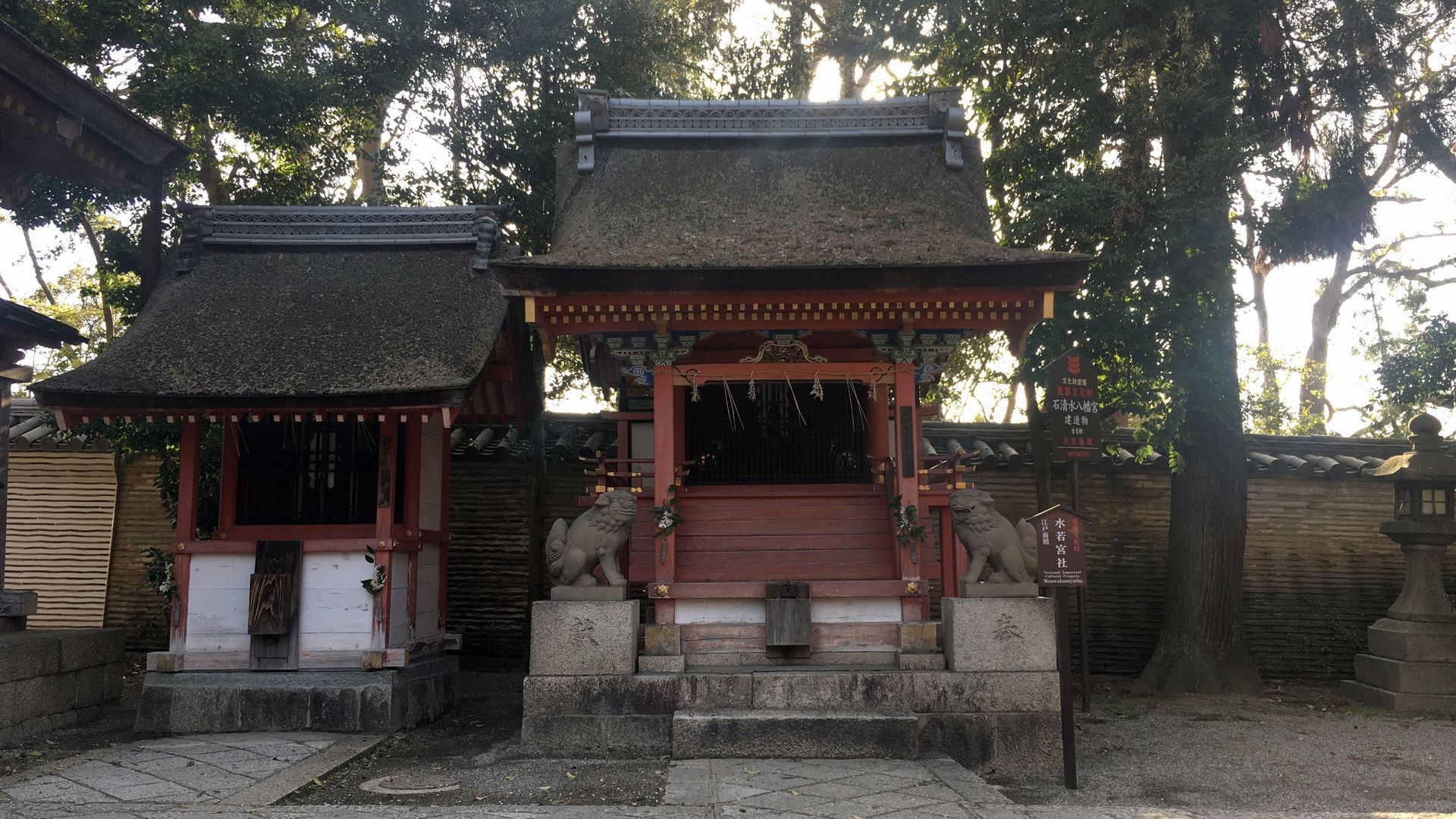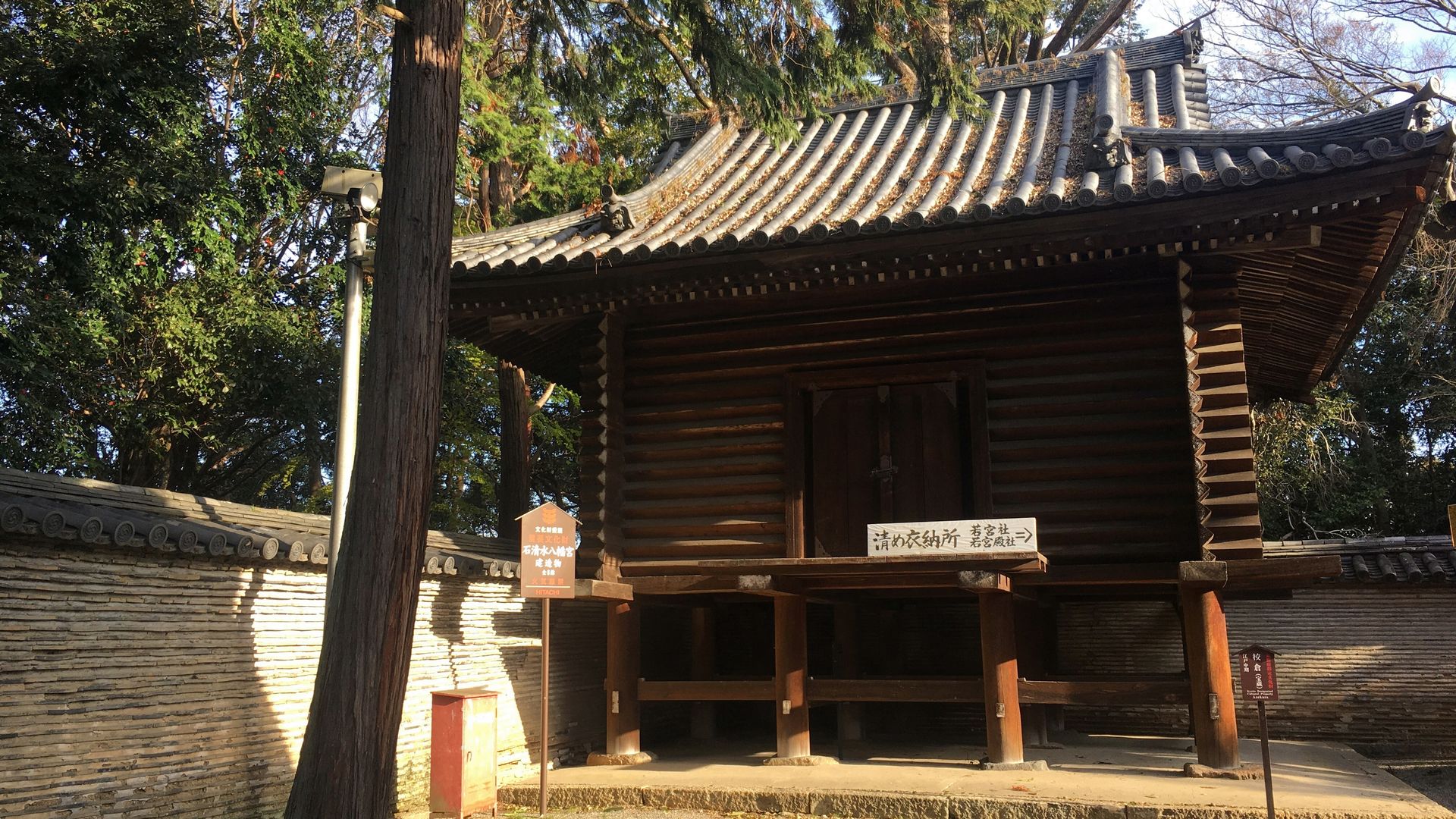Iwashimizu- Hachimangu Shrine is a Shrine located in Yawata City, Kyoto.
It was ranked as Fusha (the prefectural shrine of either Kyoto or Osaka) in the old classification of shrines before.
It is one of the shrines on the Beppyo-jinja (別表神社) shrine of the Association of Shinto Shrines in the present.
It is also considered one of three great Hachimangu Shrines in Japan along with Usa Jingu Shrine and Hakozakigu Shrine, and one of the Twenty-Two Shrines.
History of Iwashimizu Hachiman-gu
Let’s study the history of this shrine with me.
I think that we can enjoy sightseeing of this temple more by learning the history of it. XD
It was received a deity from Usa-jingu Shrine and built in 860 of Heian period.
It became Kanpe Taisya in 1871 and it was renamed ‘Otokoyama Hachiman-gu Shrine’ and resumed the name of ‘Iwashimizu Hachiman-gu Shrine’ in 1918.
Name of this Shrine, ‘Iwashimizu,’ is taken from Iwashimizu-sha which is one of the Sessha (sub-temple) of Iwashimizu Hachiman-gu.
The main enshrined deities are the Emperor Ojin, Hime-no-kami and the Empress Jingu (they are also called Hachiman-shin).
The main shrine rebuilt by Iemitsu TOKUGAWA in 1634 of the Edo period is designated as a national treasure.
It is famous for its cherry-blossoms, also has a nickname known as ‘Yawata-no-Hachimansan’.
Information for visitors
Website
Information
Address:30, Yawata Takabo, Yawata Shi, Kyoto Fu, 614-8005, Japan
Phone:+81-75-981-3001
Foundation:860
Founder:Gyokyo (行教)
Principal image:Hachiman Okami (八幡大神)
Open (precincts)
Admission fee
Free (precincts)
Route map
Other Informations
・Photography and video recording are prohibited inside the building of this temple.
・Worship method of a Shinto shrine and a Buddhist temple, please refer to the following article.
Next, Let’s go to see the highlights of this shrine with me!
Highlights of Iwashimizu Hachiman-gu
- 一ノ鳥居:Ichi-no-Torii (1st torii)
- 頓宮殿:Tongu-den
- 五輪塔【重要文化財】:Gorinto pagoda【Important cultural property】
- 高良神社:Kora-jinja Shrine
- 二ノ鳥居:Ni-no-Torii (2nd torii)
- 表参道:Omote-sando (Front approach)
- 七曲がり:Nanamagari corner
- 大扉稲荷社:Otobirainari-sha Shrine
- 影清塚:Kagekiyo-duka
- 石清水社:Iwashimizu-sha Shrine
- 松花堂跡【史跡】:Shoka-do Ruins【Historic site】
- 三ノ鳥居:San-no-torii (3rd torii)
- 一ッ石:Hitotsu-ishi Stone
- 鳩峯寮の庭:Kyohoryo-no-niwa Garden
- 石燈籠【重要文化財】:Stone lantern【Important cultural property】
- 手水舎:Chozu-sha
- 竈神殿:Sojin-den
- 南総門:Minami So-mon (South Gate)
- 御本殿【国宝】*:Gohon-den Hall【National treasure】*
- 神楽殿:Kagura-den Hall
- 東総門【重要文化財】:Higashi So-mon (East gate)【Important cultural property】
- 水若宮社【重要文化財】:Mizu Wakamiya-sha Shrine【Important cultural property】
- 氣比社:Kehi-sha Shrine
- 若宮殿社【重要文化財】:Wakamiyaden-sha Shrine【Important cultural property】
- 若宮社【重要文化財】:Wakamiya-sha Shrine【Important cultural property】
- 貴船社/龍田社:Kifune-sha/Tatsuta-sha Shrine
- 北総門【重要文化財】:Kita So-mon (North Gate)【Important cultural property】
- 一童社:Ichido-sha Shrine
- 住吉社【重要文化財】:Sumiyoshi-sha Shrine【Important cultural property】
- 校倉:Azekura
- 廣田社/生田社/長田社:Hirota-sha/Ikuta-sha/Osada-sha Shrine
- 西総門【重要文化財】:Nishi So-mon (East Gate)【Important cultural property】
- 三女神社:Sannyo-jinja Shrine
- エジソン記念碑:Edison monument
- 涌峯塔:Yuhoto Tower
- 裏参道:Ura-sando (Back approach)
- 八角堂【史跡】:Hakkaku-do Hall【Historic site】
This mark 「*」 is a pay area.
一ノ鳥居:Ichi-no-Torii (1st torii)
頓宮殿:Tongu-den
Tongu-den Hall was built in 1915 of the Taisho period.
Minami-mon (south) gate of the Tongu-den, rebuilt in 1939 of the Showa period.
五輪塔【重要文化財】:Gorinto pagoda【Important cultural property】
This tower was built to pray for the safety of the voyage.
It is the biggest gorinto pagoda in japan, designated as an important cultural property.
高良神社:Kora-jinja Shrine
Kora-jinja shrine is the local tutelar deity of Yawata City.
二ノ鳥居:Ni-no-Torii (2nd torii)
表参道:Omote-sando (Front approach)
七曲がり:Nanamagari corner
大扉稲荷社:Otobirainari-sha Shrine
It was built in 1829 of the Edo period for worshiping Inari God.
影清塚:Kagekiyo-duka
石清水社:Iwashimizu-sha Shrine
It is a tangible cultural property designated by Kyoto Prefecture.
松花堂跡【史跡】:Shoka-do Ruins【Historic site】
It is the ruin of the Shoka-do which was the tea room and jibutsudo (a small hut with an Buddhist alcove).
三ノ鳥居:San-no-torii (3rd torii)
一ッ石:Hitotsu-ishi Stone
It is the starting point of Ohyakudo-mairi (ritual of visiting and praying at the same shrine a hundred times).
鳩峯寮の庭:Kyohoryo-no-niwa Garden
This garden was designed in 1966 of the Showa period by Mirei SHIGEMORI.
石燈籠【重要文化財】:Stone lantern【Important cultural property】
This garden was designed in 1952 of the Showa period by Mirei SHIGEMORI.
The stone lantern of this garden made in the Kamakura period is designated a national important cultural property.
手水舎:Chozu-sha
Chozusha is the building for cleaning hands and rinsing mouth.
Please refer to the following article.
竈神殿:Sojin-den
Hinokagutsuchi-no-Kami, the god of fire and kitchen, is enshrined.
南総門:Minami So-mon (South Gate)
御本殿【国宝】*:Gohon-den Hall【National treasure】*
The main shrine rebuilt by Iemitsu TOKUGAWA in 1634 of the Edo period is designated as a national treasure.
Hachiman Okami is enshrined in this building.
神楽殿:Kagura-den Hall
Kagura-den Hall has the role of the place for playing Shinto music and dance.
東総門【重要文化財】:Higashi So-mon (East gate)【Important cultural property】
水若宮社【重要文化財】:Mizu Wakamiya-sha Shrine【Important cultural property】
氣比社:Kehi-sha Shrine
The right hand side of the picture is Mizu Wakamiya-sha Shrine, enshrined deity is Uji no Waki no Iratsuko no Mikoto.
The left hand side of the picture is Kehi-sha Shrine, enshrined deity is God of Kehi who is the main enshrined deity of the Kehi Jingu Shrine (Fukui prefecture).
若宮殿社【重要文化財】:Wakamiyaden-sha Shrine【Important cultural property】
Because the daughter of Emperor Ojin is worshiped in Wakamiyaden-sha Shrine, especially believed by women.
若宮社【重要文化財】:Wakamiya-sha Shrine【Important cultural property】
Because the son of Emperor Ojin is worshiped in Wakamiya-sha Shrine, especially believed by men.
貴船社/龍田社:Kifune-sha/Tatsuta-sha Shrine
The right hand side of the picture is Tatsuta-sha Shrine, enshrined deity is Shinatsuhiko no kami who is the main enshrined deity of the Tatsuta Taisha Shrine (Nara prefecture).
The left hand side of the picture is Kifune-sha Shrine, enshrined deity is Takaokami-no-kami who is the main enshrined deity of the Kifune Jinja Shrine (Kyoto prefecture).
北総門【重要文化財】:Kita So-mon (North Gate)【Important cultural property】
一童社:Ichido-sha Shrine
住吉社【重要文化財】:Sumiyoshi-sha Shrine【Important cultural property】
The right hand side of the picture is Ichido-sha Shrine, enshrined deity is Azuminoisora who is a deity of the sea within the religion of Shinto.
The left hand side of the picture is Sumiyoshi-sha Shrine, enshrined deity is Sumiyoshi Okami who is the main enshrined deity of the Sumiyoshi Taisha Shrine (Hyogo prefecture).
校倉:Azekura
Azekura has the role of treasure house.
It is built with a style of architecture called square log architecture.
廣田社/生田社/長田社:Hirota-sha/Ikuta-sha/Osada-sha Shrine
The right hand side of the picture is Nagata-sha Shrine, enshrined deity is Kotoshironushi-no-kami who is the main enshrined deity of the Nagata Jinja Shrine (Hyogo prefecture).
The center of the picture is Ikuta-sha Shrine, enshrined deity is Wakahirume no mikoto who is the main enshrined deity of the Ikuta Jinja Shrine (Hyogo prefecture).
The left hand side of the picture is Hirota-sha Shrine, enshrined deity is Amaterasu Omikami (the God of the sun) who is the main enshrined deity of the Hirota Jinja Shrine (Hyogo prefecture).
西総門【重要文化財】:Nishi So-mon (East Gate)【Important cultural property】
三女神社:Sannyo-jinja Shrine
Munakata Sanjojin who is a collective name for Mihashira no menokami (three female gods) enshrined at Munakata Taisha Shrine (Fukuoka Prefecture) is enshrined in this shrine.
エジソン記念碑:Edison monument
涌峯塔:Yuhoto Tower
裏参道:Ura-sando (Back approach)
八角堂【史跡】:Hakkaku-do Hall【Historic site】
Cherry blossoms of Iwashimizu Hachiman-gu
The best season of cheryy blossoms is early April.
Video of Iwashimizu Hachiman-gu
Photo of Iwashimizu Hachiman-gu
Iwashimizu Hachimangu Shrine (Yawata City, Kyoto):石清水八幡宮(京都府八幡市)
Goshuin (Red ink stamps) of Iwashimizu Hachiman-gu
Goshuin (red ink stamp) of the Iwashimizu Hachiman-gu Shrine, ‘Hachiman Okami (八幡大神)’, the main enshrined deity of this Shinto shrine.
How to get to Iwashimizu Hachiman-gu
The nearest station is Keihan Yawatashi Sta.
From Osaka Sta. (by train)
Timetable and Route Search (train)
①Please get on the JR Osaka Loop Line from Osaka Station to Kyobashi Station.
②Please change to the Keihan Railway at Kyobashi Station.
③Please get on the Keihan Railway from Kyobashi Station to Yawatashi Station.
From Namba Sta. (by train)
Timetable and Route Search (train)
①Please get on the Osaka Metro (Subway) Midosuji Line from Namba Station to Yodoyabashi Station.
②Please change to the Keihan Railway at Yodoyabashi Station.
③Please get on the Keihan Railway from Yodoyabashi Station to Yawatashi Station.
From Kyoto Sta. (by train)
Timetable and Route Search (train)
①Please get on the JR Nara Line from Kyoto Station to Tofukuji Station.
②Please change to the Keihan Railway at Tofukuji Station.
③Please get on the Keihan Railway from Tofukuji Station to Yawatashi Station.
From Yawatashi Sta. (by cable car)
From Yawatashi Sta. (on foot)
Take a taxi
From Kyoto Station:5200 yen ~ (about 30 minutes)
From Gion-Shijo Station:6000 yen ~ (about 40 minutes)
・Let’s show a taxi driver the following phrase.
・If you want to call a taxi, let’s show the following phrase.
[Phone number of taxi dispatch : Around the Kyoto Station]*Japanese text only.
Hotel search & reservation
How did you like it?
Have a nice trip! XD












